Darkrise is a hugely underrated mobile action role-playing game (RPG) created by indie development studio, Roika (presumably led by solo lead, Victor Chokov).
Sharing fast-paced combat akin to the likes of Ninja Warrior 2, the game is expanded by its deep gearing mechanics and large in-game world to explore.
Despite its glowing first impressions, though, Darkrise‘s difficulty ramps up quite quickly for the uninitiated, so here’s a quick guide to help prepare you beforehand.
Hero Of A Lost Land
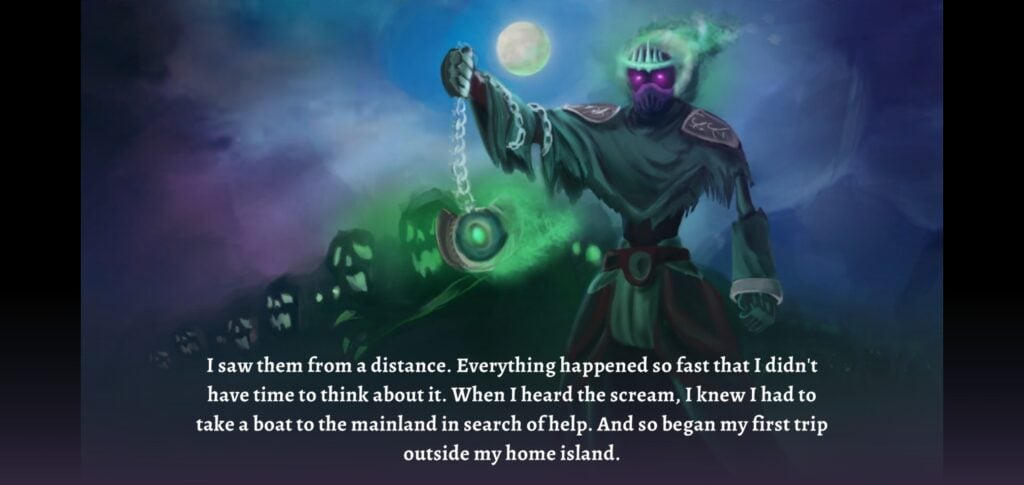
Photo: Roika
In Darkrise, you start as a native of the Broken Islands, a seemingly small archipelago neighboring other bigger islands, such as Kalgar Island or the Acid Lands.
Although you’ve lived a peaceful and uneventful life at your settlement, things take a horrible turn when a mysterious faction attacks your home, forcing you to seek aid by venturing to other locations, building you up as a glorious hero.
Truthfully, Darkrise‘s overall narrative is almost non-existent the moment you play the game, especially when you continue to bolster yourself as a fearsome fighter by defeating enemies and completing quests instead of actually asking for help as referenced in the cut scene.
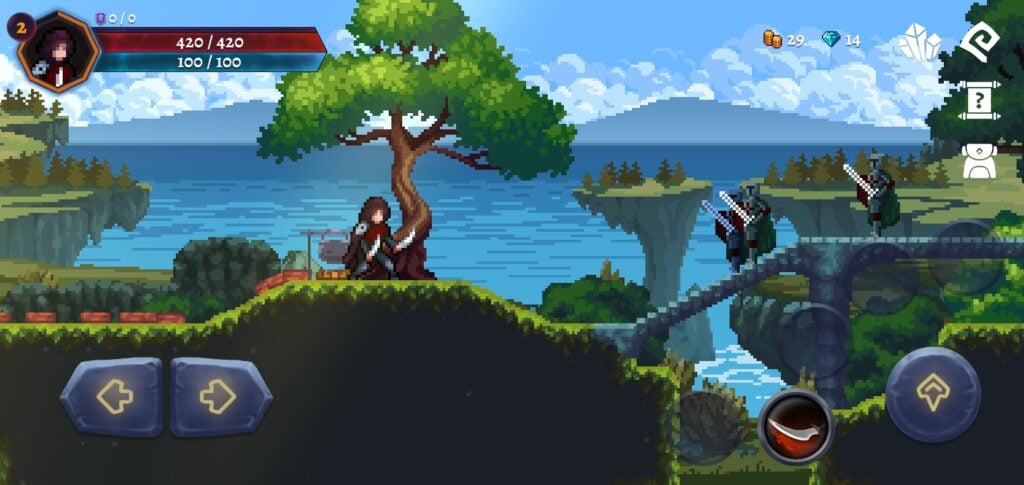
Photo: Roika
Still, the game’s primary appeal is its nostalgic art style and extensive RPG elements, reminding you of the good old days of retro titles like 1986’s Castlevania.
Darkrise‘s freedom to explore different locations – including revisiting those you’ve cleared/ visited before – opens up more replayability for you to grind for EXP, loot, and materials, some of which are crucial for end-game challenges.
Despite its linear game design, you’ll spend many hours savoring the game’s distinct enemy variations, satisfying gear grind, and surprise hidden areas in-game.
Basic Mechanics
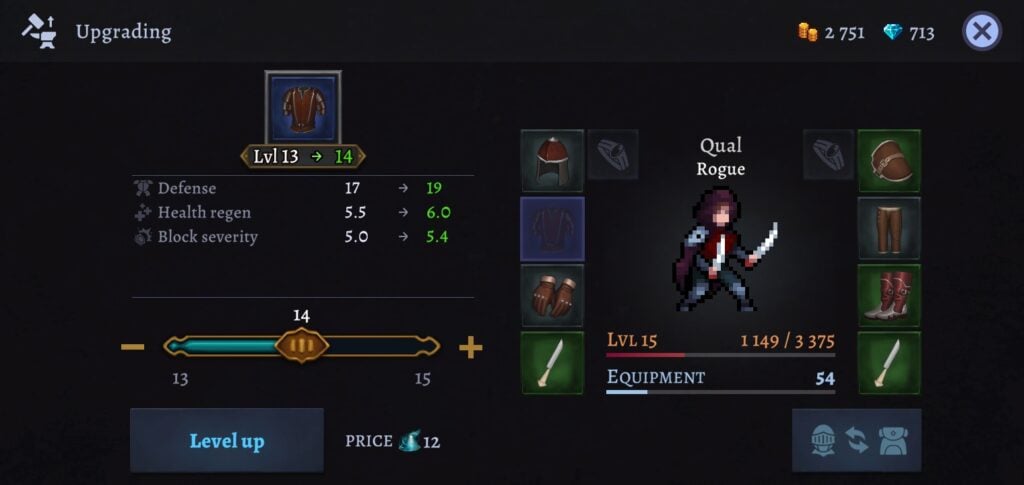
Photo: Roika
Being a mobile game, Darkrise isn’t expected to be as big as a dedicated PC or console game. That being said, the developer did a great job elevating your experience by setting up multiple layers of progression through different in-game mechanics.
Here’s a look at each of them:
In-Game Currencies
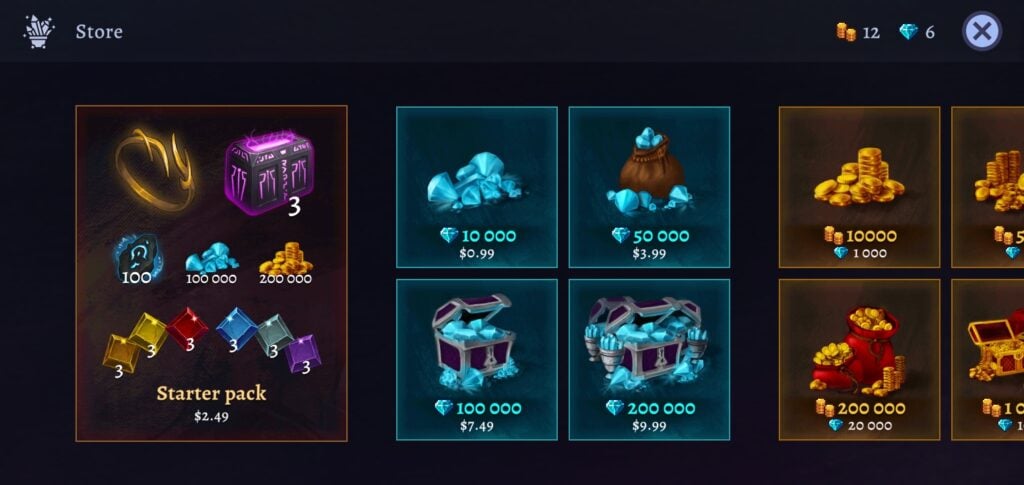
Photo: Roika
As with any free-to-play (F2P) mobile game, Darkrise‘s in-game currencies are among the most important things you must first understand. These are separated into two, each being:
- Gold
- Gold is the common currency used for every in-game transaction with non-player characters (NPCs).
- Diamonds
- Diamonds (different from Gems which are another gameplay aspect) are Darkrise‘s premium currency used for more exclusive purposes, such as enchanting equipment or buying gathering tools.
Essentially, the game is completely playable from start to finish without you spending a single cent, but the developer wouldn’t get anything fruitful out of their hard work then.
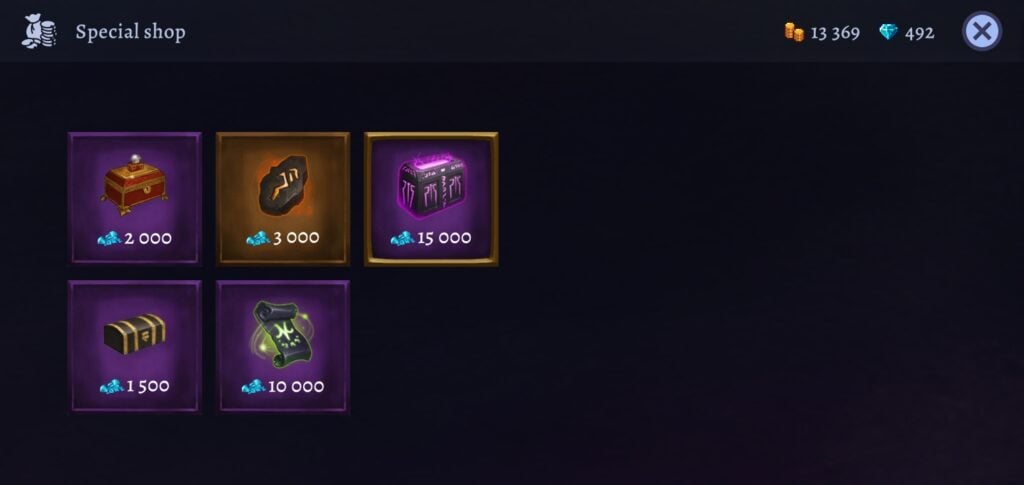
Photo: Roika
Hence, certain power-creeping accesses are locked behind expensive Gold or Diamond rates, to which actual Store purchases can help mitigate the copious grind.
Regardless, Darkrise is still considered among the most F2P-friendly games on the mobile market due to its generally cheap microtransaction prices, so consider supporting the developer, Roika, if you are financially sound to do so.
Character Classes
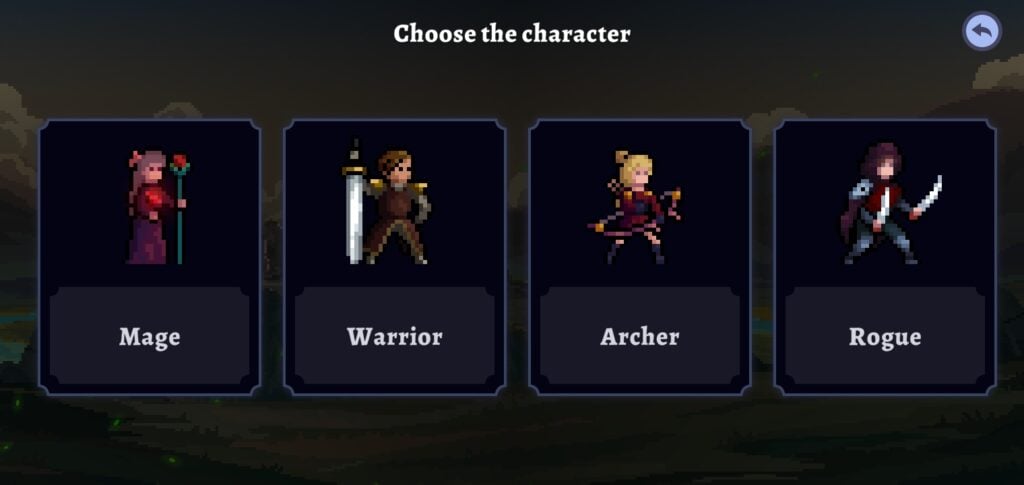
Photo: Roika
Immediately after launching the game, you’ll be greeted by the character selection screen, letting you pick your preferred avatar between the following four class choices:
- Mage
- Darkrise‘s glass cannon vocation, a Mage is deadly at conjuring area-of-effect (AoE) spells, devastating large crowds of enemies simultaneously.
- Warrior
- The Warrior is the ideal beginner’s choice due to the class’s immense survivability and heavy-hitting attacks.
- Archer
- As the name implies, the Archer is a master at long-range bow and arrow marksmanship.
- Rogue
- The Rogue is extremely quick and agile, lacing their weapons with poison or bleeding effects to debilitate foes while dancing around incoming attacks.
Each class represents different playstyles, offering unique advantages and shortcomings that define your overall experience from start to finish.
Weapons & Equipment
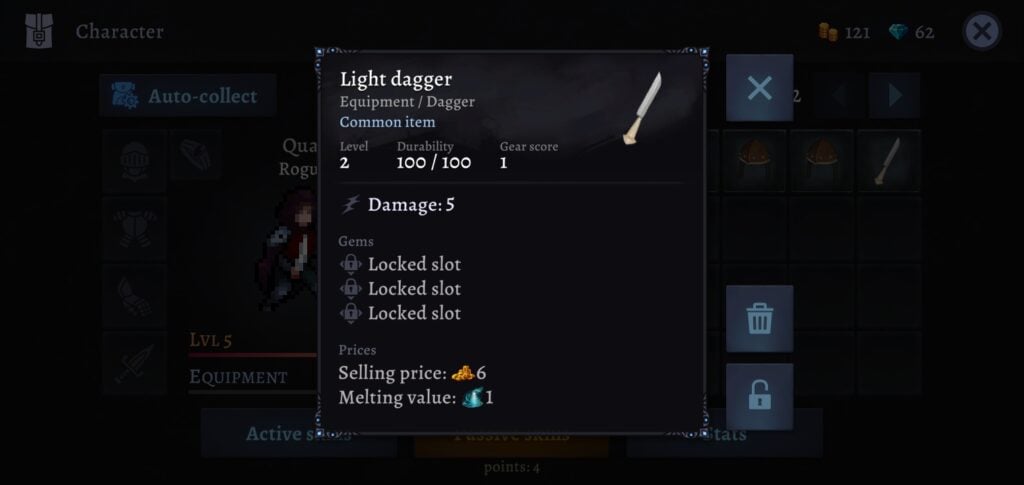
Photo: Roika
As an RPG, there are hundreds of different gear you can find and equip on your hero in Darkrise. Furthermore, you can consume or mix specific food and items to make even better consumables that improve your stats for a brief period.
In terms of the equipment – including weapons – that you can have on your character, you’ll have ten slots to fill, encompassing:
- 1x Helm
- 1x Chest Armor
- 1x Gloves/ Bracers
- 1x Pauldron
- 1x Pants
- 1x Boots
- 2x Accessories (e.g. Rings)
- 2x Weapons (including Shields)
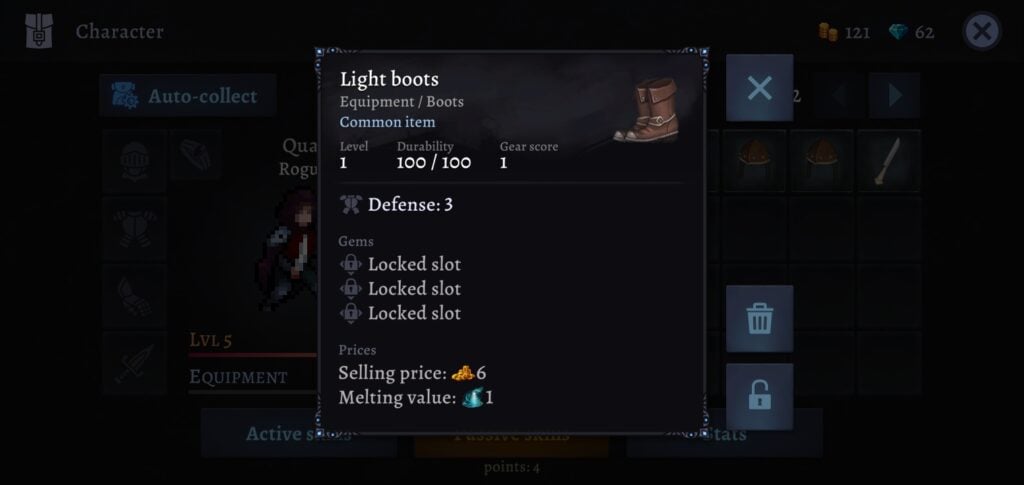
Photo: Roika
Each gear has its own level, rarity, and randomly generated stats, directly dictating its overall gear score too in Darkrise. Speaking of gear rarity, there are six types in the game, which are (listed from the most basic to the most powerful):
- Common (grey)
- Uncommon (green)
- Rare (blue)
- Epic (purple)
- Legendary (brown/ orange)
- Mythical (cyan)
This grading extends to collectible items too, such as consumables like Apples. Normally, rarer/ higher-grade equipment or items have more stat bonuses (e.g. stats for Health, Mobility, Damage, etc.), justifying their more desirable states.
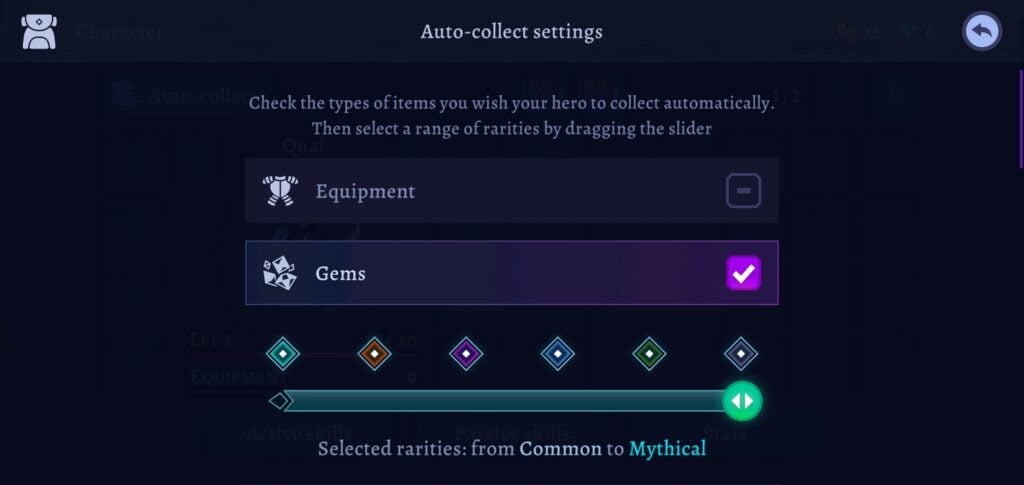
Photo: Roika
Items collected during your travels have explanations detailing their uses, including trash sellable to vendors, such as Bones. Furthermore, weapons and wearable equipment can be tampered with via the following means:
- Inserting Gems (add bonus stats according to the Gem used)
- Enchanting them to increase stats (e.g. Gauntlets of Fortune +1, etc.)
- Leveling them up (increase the equipment’s level to be on par with the hero’s)
- Repaired to replenish Durability
- Disenchant gear to receive Gold and Diamonds
- Etc.
As mentioned earlier, Darkrise adopts deep RPG elements that make it deserving of your attention.
Skills
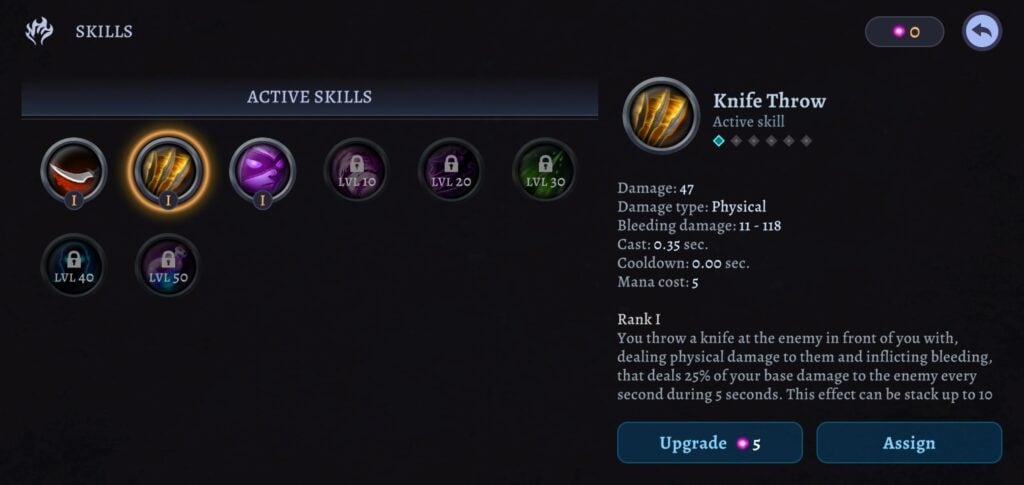
Photo: Roika
Depending on the character class you opted for, unique skills will then be introduced to your combat proficiency. Whether you favored the Archer to rain down non-stop arrow bombardments from afar or likened the Warrior to face foes head-on, skills are split into two types:
- Active Skills
- These are abilities that can be triggered by command, usually consuming Mana.
- Passive Skills
- These are the stats you choose to increase (upon leveling up) via an interlinking Skill Tree, with some introducing new mechanics (e.g. stackable Damage bonuses)
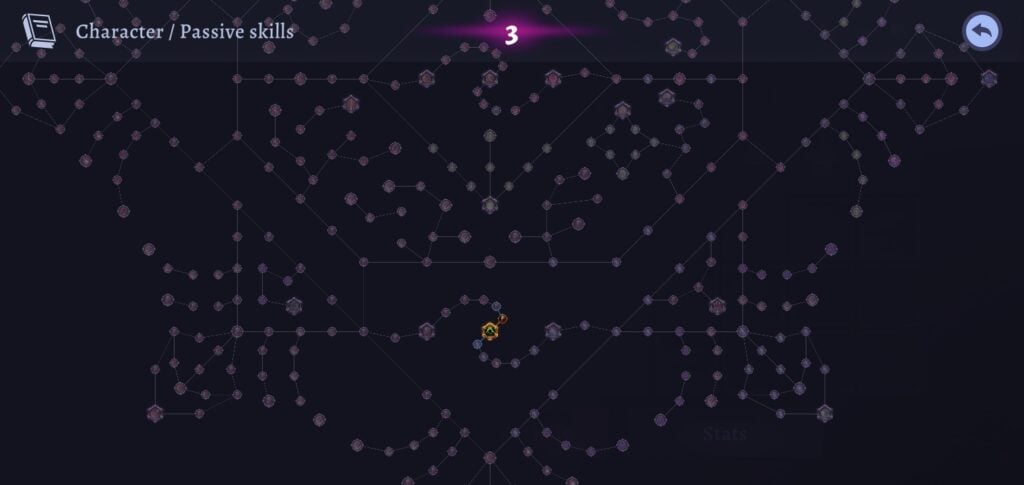
Photo: Roika
Focusing our attention on the Active Skills, each ability can be further enhanced by consuming Active Skill Points (represented by a purple orb icon) that are acquired through in-game Books found as loot.
Once you enter the late game in Darkrise, you’ll be pleasantly surprised at how mighty your hero can actually become later on.
Crafting
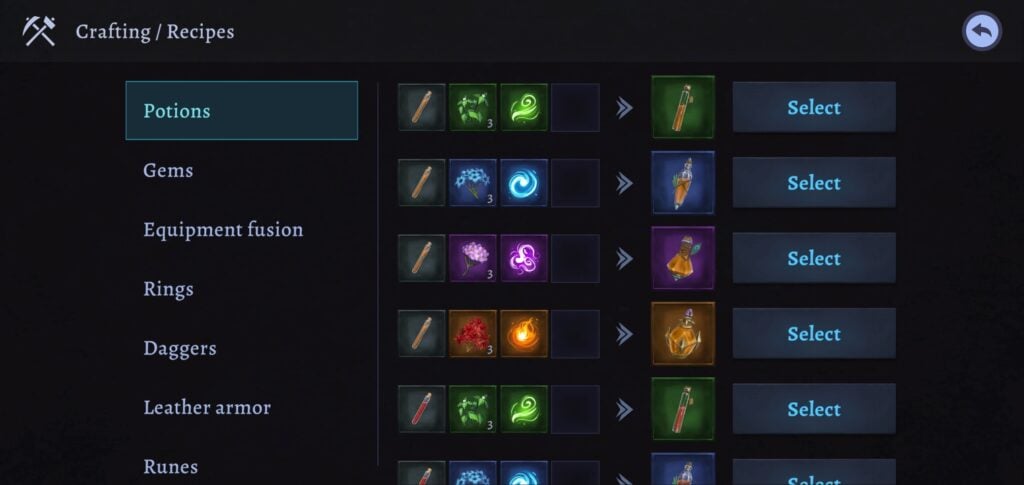
Photo: Roika
Another key aspect of Darkrise is its Crafting system, which isn’t available from the beginning. You’ll need to reach a certain stage to be introduced to it, but it becomes an essential part of your hero’s progression once unlocked.
To craft new items, weapons, or gear, you’ll need to gain access to its respective vendors in towns. Once talked to, you can combine up to four different materials/ items to create a new one, depending on its availability in the game’s Recipe Book.
The Recipe Book is quite extensive, but as a quick run-through, these are the recipe categories contained within:
- Potions
- Gems
- Equipment Fusion
- Rings
- Weapons (depending on character class)
- Armor (depending on character class)
- Runes
- Legacy Resources
- Legacy Gems
So, it might be better to craft your preferred weapons or equipment instead of buying them from NPC vendors around town. That being said, it’ll depend on how good your resource-gathering skill is, which is something else entirely.
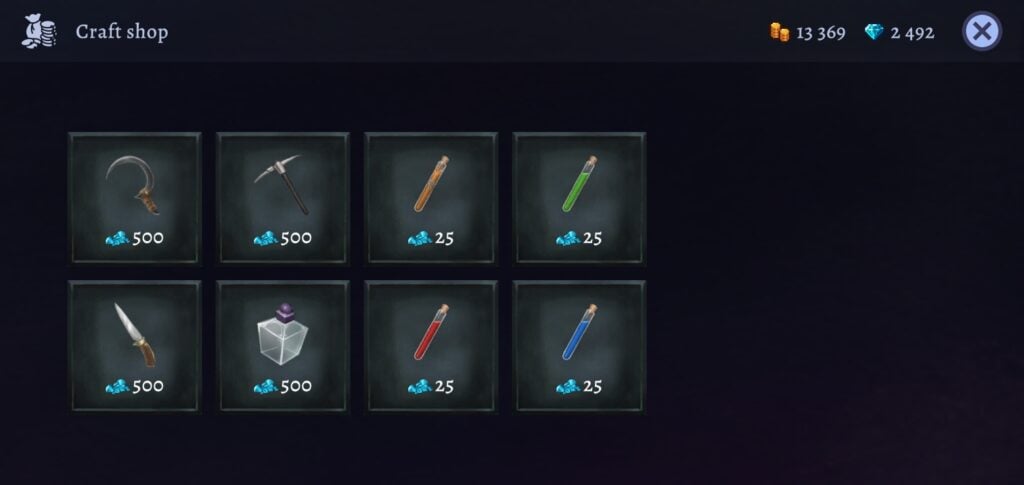
Photo: Roika
In order to acquire the materials needed for crafting, you’ll need the respective Tools to do so, such as:
- Sickle
- Used for cutting certain plants.
- Pickaxe
- Used to extract ore or other earthen materials.
- Flask
- Used to store energies (e.g. Water Energy).
- Knife
- Used to skin the associated animals or beasts defeated.
Without these inside your inventory, you can’t collect the necessary materials for crafting, making them essential tools to be had AT ALL TIMES.
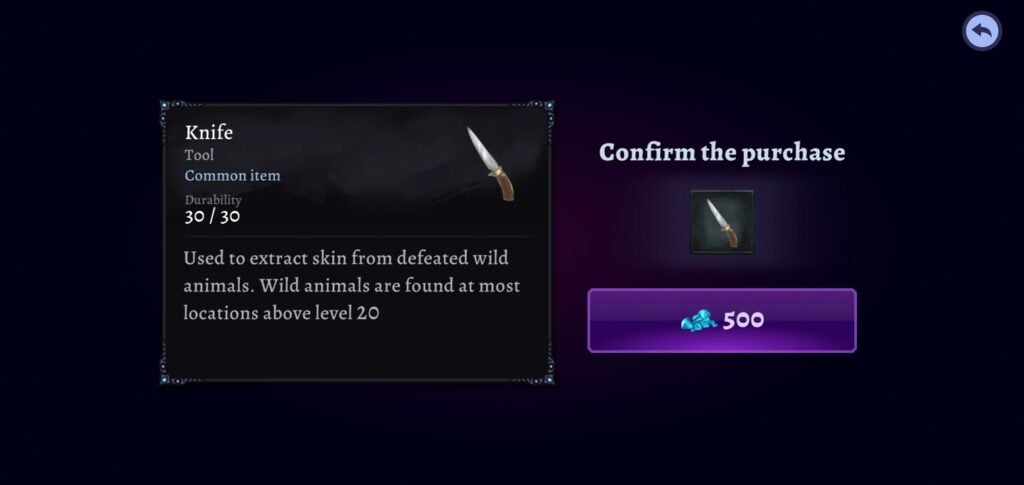
Photo: Roika
On the other hand, another distinct mechanic pertaining to weapons, equipment, and Skill Books is melting, producing the resources needed for other crafting uses.
To melt any weapon, body gear, or book to acquire the respective Magic Substance (from melting gear) or Essence of Enlightenment (from melting books), you need to visit a melting area first, which is also only found once you’ve progressed a bit further into the game.
Gameplay
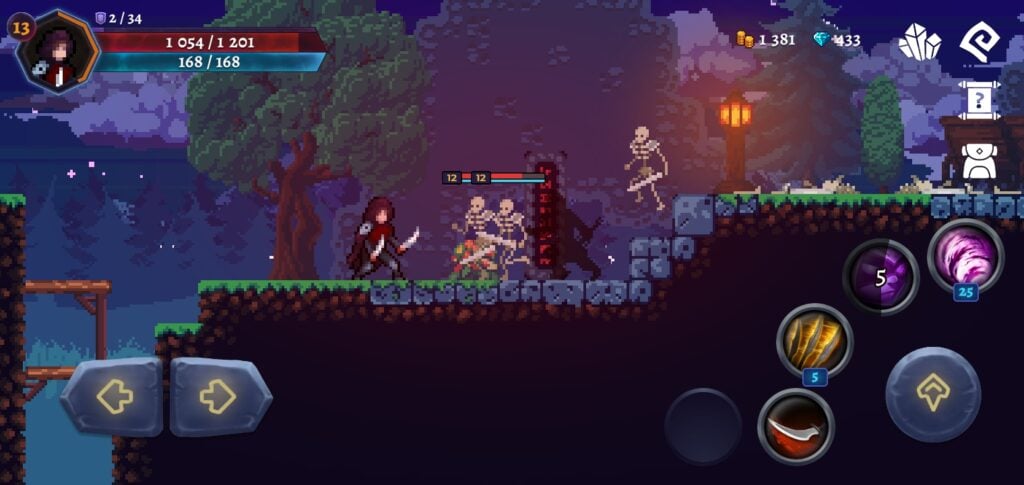
Photo: Roika
Now, it’s time for you to dive into Darkrise‘s gameplay components next. These mainly revolve around:
Combat
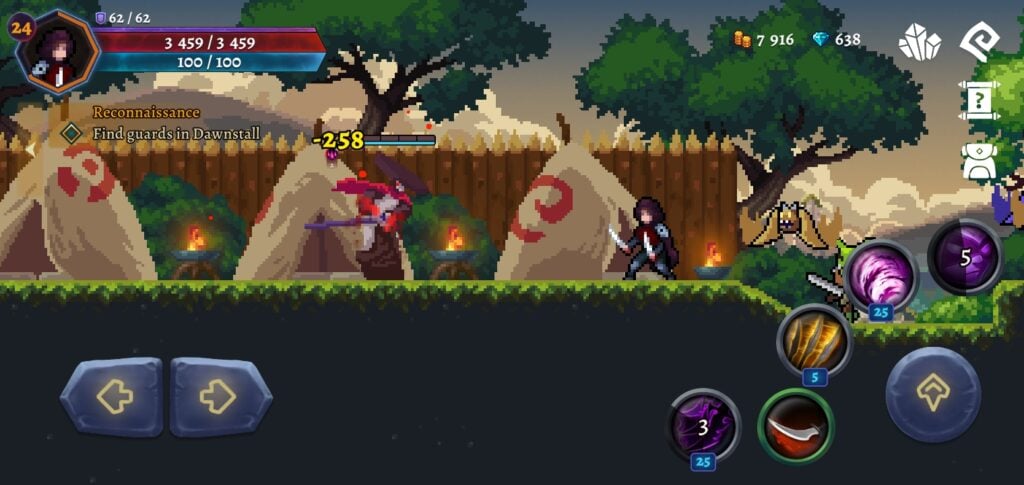
Photo: Roika
Darkrise‘s combat is its bread and butter; your in-game progress is tied heavily to the gameplay loop of clearing levels swarming with otherworldly creatures and challenging adversaries.
The game plays out as a 2D side-scroller, but the animations are fluid and delightful, notably when you’re using your skills to take out enemies nearby.
When it comes to the user interface (UI), mostly you’ll be looking at:
Player details (top-left corner)
Here, you’ll get brief information about your hero’s:
- Current level
- EXP bar (encapsulating the character’s image)
- Energy shield (small purple bar)
- Health (red bar)
- Mana (blue bar)
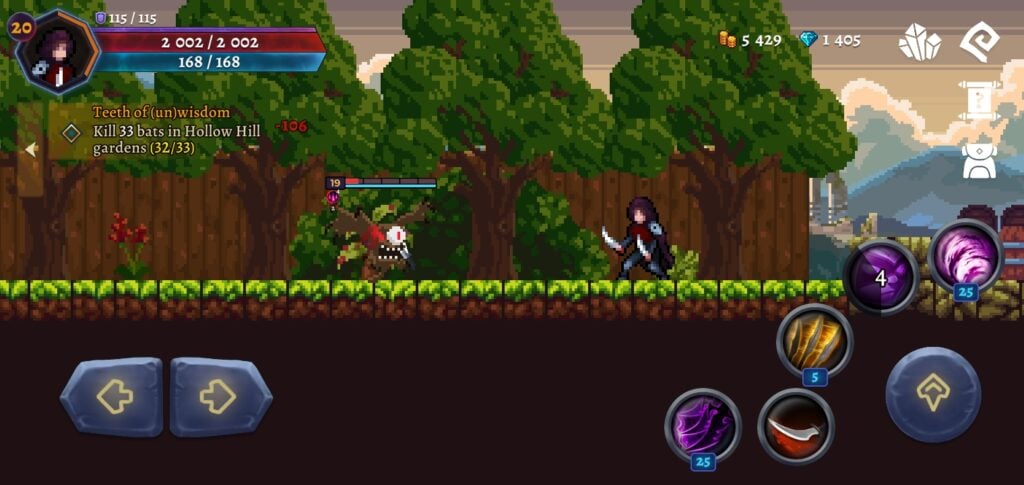
Photo: Roika
Player actions (bottom-right corner)
This section pertains to your character’s:
- Current Active Skills selected
- Jumping button
You can change the skills’ order by opening the Inventory (the bag icon) and then checking the Active Skills page underneath. Once there, click the Assign option to change the order or skills to be used.
World Zones/ Instances
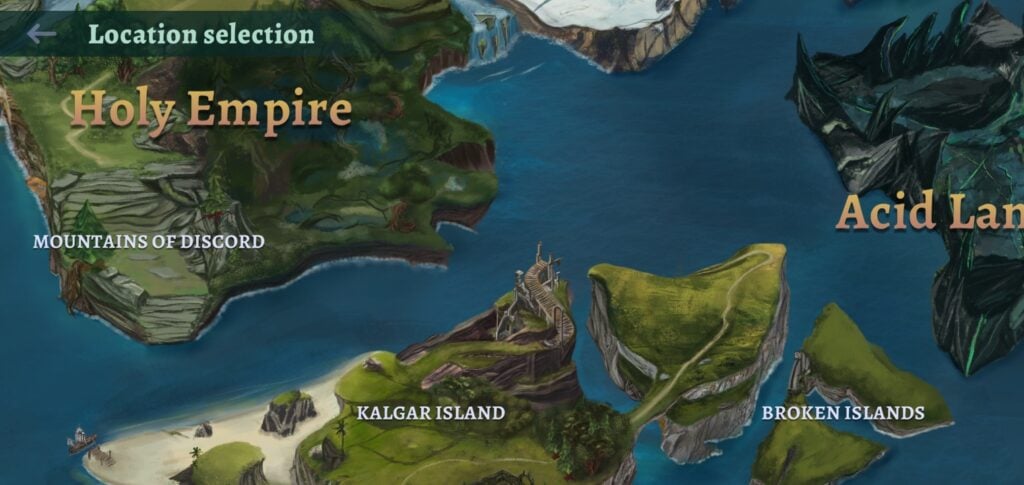
Photo: Roika
Darkrise boasts quite an expansive in-game world for you to explore. In total, there are four unique regions in the continent, each being:
- Holy Empire
- Osang
- Orion Kingdom
- Acid Lands
In each region, there are many in-game zones/ instances and town hubs as well. At the moment, Darkrise seems to be capped at Bridge of Stagnation (Level 151- Level 200) in the Lands of Stagnation under the Holy Empire region, with Osang and the Acid Lands still inaccessible.
This can easily change as time flies by, with the developer still adding more content and challenges into the game as we speak.
For what it’s worth, the number of stages currently completed already makes the game feel complete, so future additions will likely be welcomed very well by the player base.
Difficulty Options
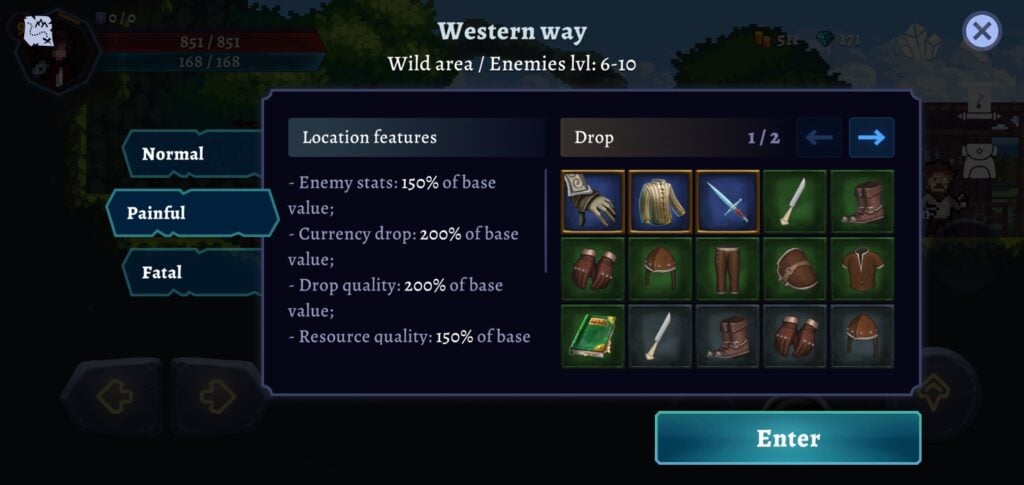
Photo: Roika
For every in-game stage/ level, there are three difficulty options you can cycle through, each affecting the enemies’ strengths while adjusting the loot drops.
This ensures that previously completed areas can be revisited at a more challenging demeanor, accommodating your improved stats. For every area, the difficulty options you can choose from are:
- Normal
- All variables are kept at their set standards.
- Painful
- Slightly improved stats for enemies, but much better chances for loot.
- Fatal (only accessible by exchanging 10x Key of Power)
- Amazing loot drops but exceedingly powerful monsters.
With the difficulty options in place, you’re sure to replay Darkrise for longer to farm for exquisite materials, test out new gear, or just have fun!
Quests

Photo: Roika
Understandably, repeated grind can become stale and boring after a time. Hence, quests are also in the game, letting you help NPCs which in turn rewards you with amazing gear or open up new side storylines.
These range from simple gathering tasks to eliminating monsters, but they’re more of a charming distraction to pull you into the game’s world than anything else, which is still appreciated.
Tips & Tricks in Darkrise
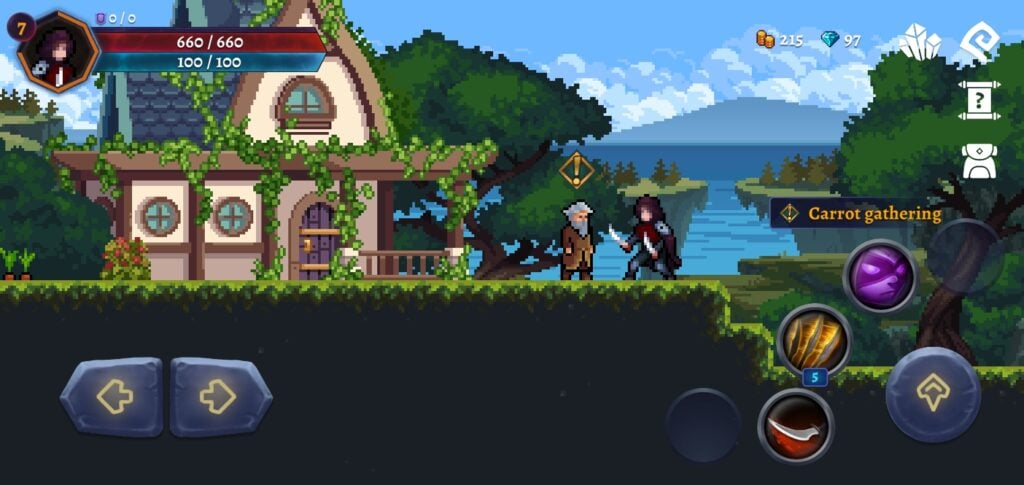
Photo: Roika
To fully grasp Darkrise‘s full potential, you’ll have to endure its tough grind and the arduous trek across different regions to unlock even more features and possibilities. Luckily, here are a few tips & tricks that could come in handy for you:
1. Non-stop attack while moving
If you didn’t know, you can actually hold the attack button to persistently attack enemies while moving and jumping.
This helps tremendously when going up against hordes coming at you from all sides, negating the need to click the button repeatedly to execute single attacks.
2. Higher jumps
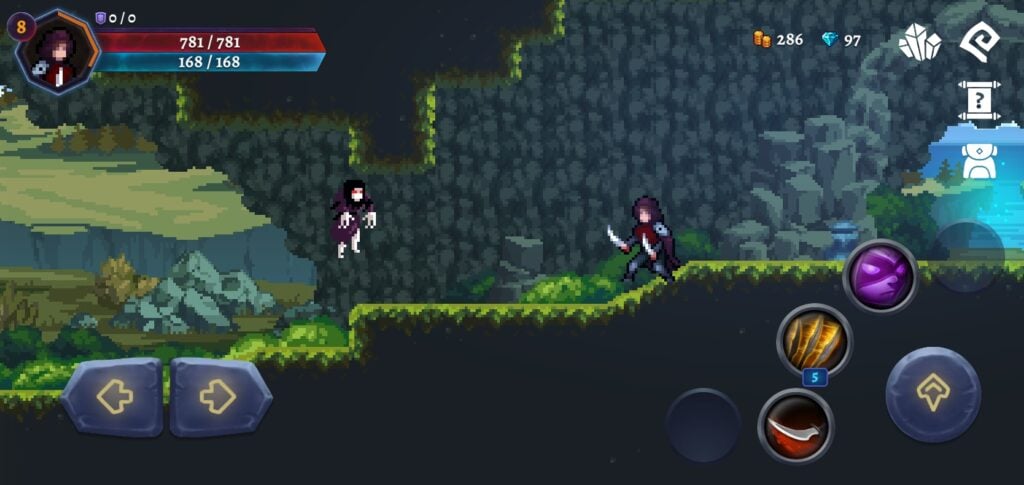
Photo: Roika
Although you can’t double-jump in Darkrise, you can actually jump higher and multiple times by pressing the jump button as soon as you come into contact with a traversable object or the ground.
This is made easier by holding the jump button, letting your character continuously jump around the map, and triggering the high jump once they step on the necessary object or elevated soil.
3. Durability (repair at the minimum value)
Always remember to repair your damaged weapons or equipment once it’s near its broken state (e.g. Durability: 2/10) instead of doing it while they’re still fine (e.g. Durability 25/30).
This helps you save Gold for the long run, especially for the mid-to-late game where everything becomes much more expensive!
4. Consume food for buffs
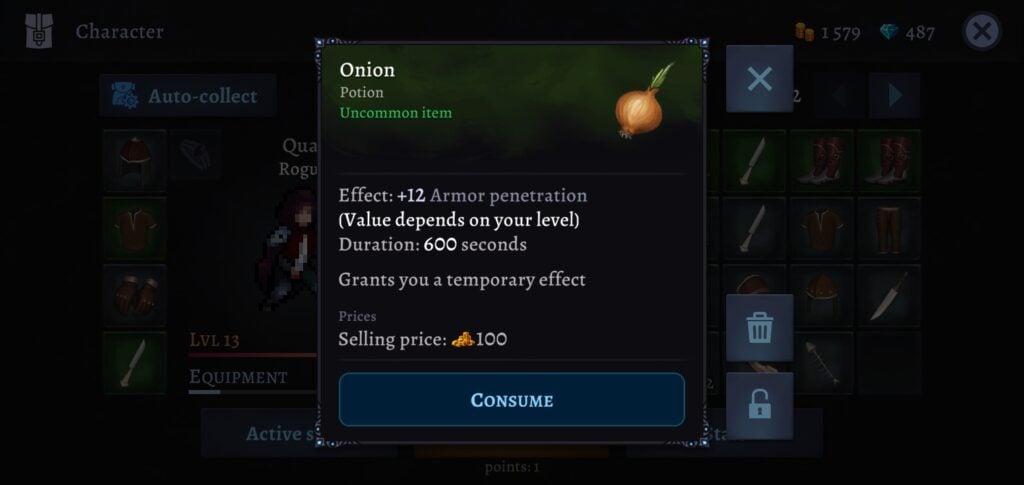
Photo: Roika
During your adventure, you’ll come across many consumable foods as loot. While some of them can be kept for later (particularly as ingredients for other recipes), it might be wiser for you to eat the others instead.
Food, such as the Onion, provides a much-needed stat increase lasting a few minutes, which can make the difference when trying to rid the lands of nightmarish ghouls or vampires.
5. Social distancing
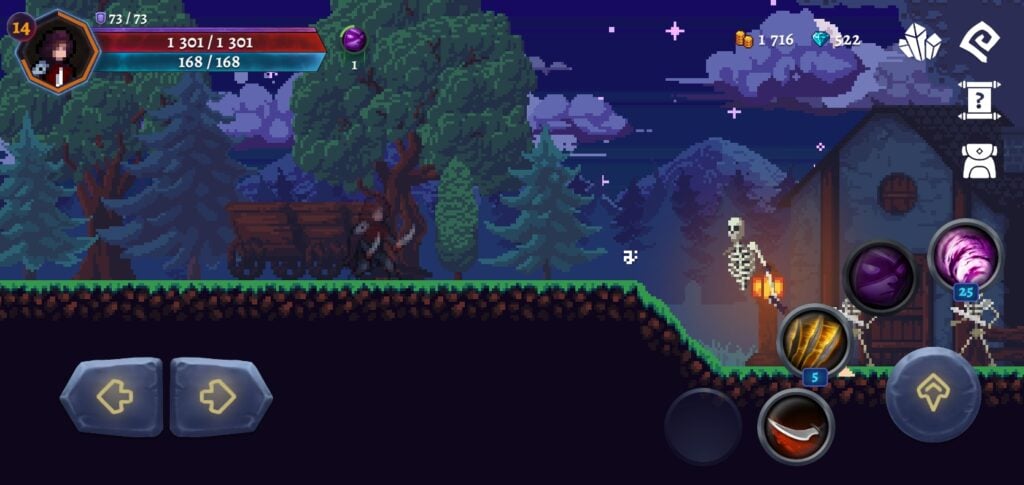
Photo: Roika
Your foes might look pixelated and harmless on the phone screen, but they’re really dangerous to your character. In the early stages, a few hits can quickly get you killed, undoing all your hard work at that point.
Attack your enemies from a safe distance as much as you can, even if you’re playing as the Warrior. It takes some practice to get used to, but that also makes you more skilled at the game!
6. Group ’em up!
In Darkrise, you can hit multiple enemies in a single swipe using your melee weapon. Use this to your advantage as the Warrior or Rogue, cutting adversaries to pieces in less than a second.
The Mage and Archer have AoE skills of their own, so this applies to them too by using them against clumped-up foes on the screen.
7. Discover hidden areas
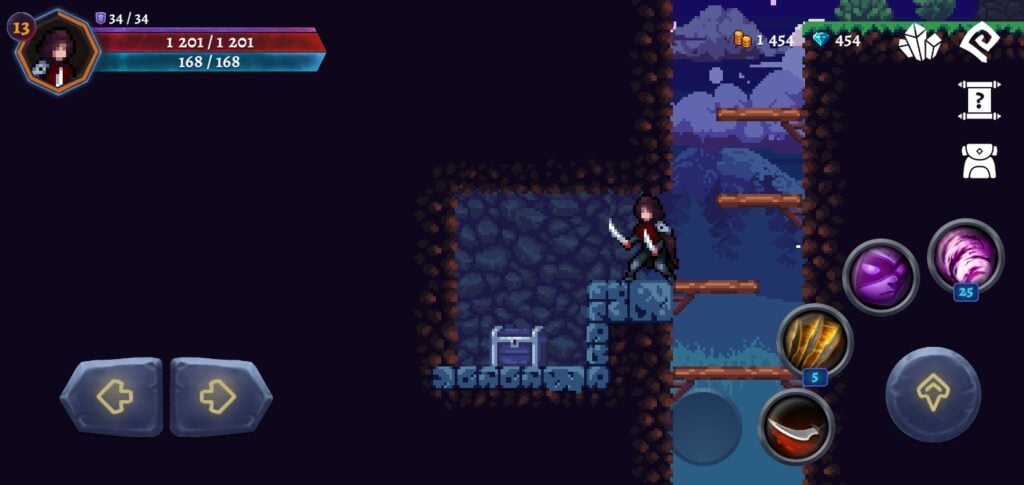
Photo: Roika
The developer did a spectacular job of hiding various entry points to hidden grottos or shortcuts in the game. You might not know it, but you could’ve missed a secret chest that’s impossible to spot, so bump around every object and map to check for any mysterious spots – literally!
8. Teleport back to town when in danger (yes, you can!)
This might be considered an exploit, but whenever you find yourself surrounded by mobs with nowhere else to go (except R.I.P.), then press the game’s menu (denoted by the symbol found at the top-right corner of the screen) and click on Town to instantly be transported to a safe area!
9. Reach Hill Town a.s.a.p.
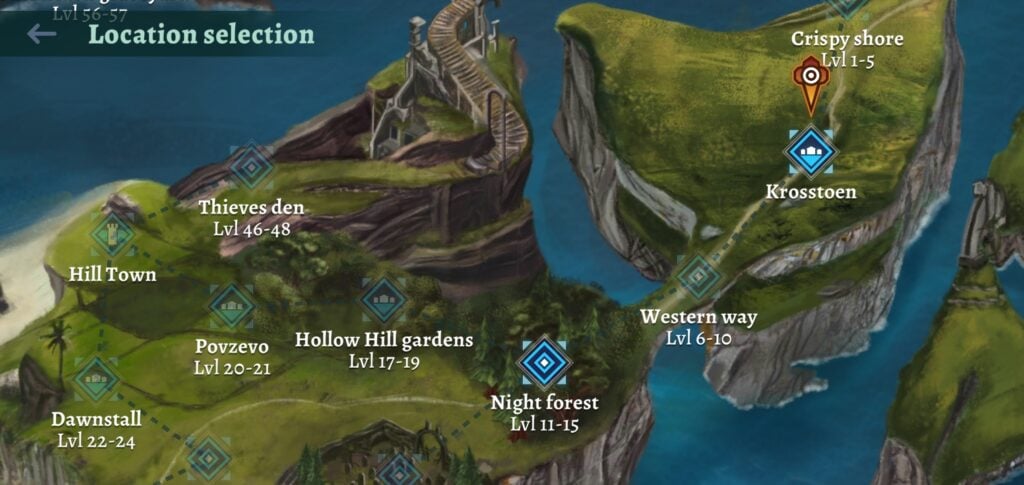
Photo: Roika
In Darkrise, Hill Town is the second safe zone (a.k.a. peaceful area in-game) that you’ll eventually pass through during your journey, the first being Krosstoen.
Just by looking at the map, it might seem a bit of a stretch, but many crucial gameplay aspects are only unlocked once you arrive there, like the melting area and storage house. So, unless you push your way through the early zones (which are relatively easy due to the enemies’ low levels), you’ll be lagging behind by a lot.
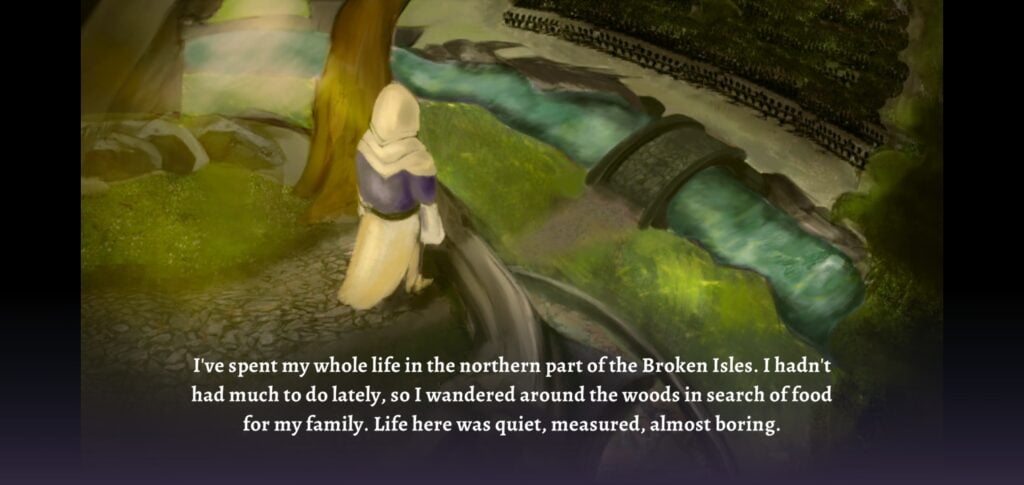
Photo: Roika
Conclusion
Darkrise is probably one of the best pixelated mobile RPGs available on both the Google Play Store and Apple App Store right now.
Still, if you’re into post-apocalyptic games like Survival Tactics, or gorgeous gacha titles such as Brown Dust II, make sure to stick around and check out their guides as well!






